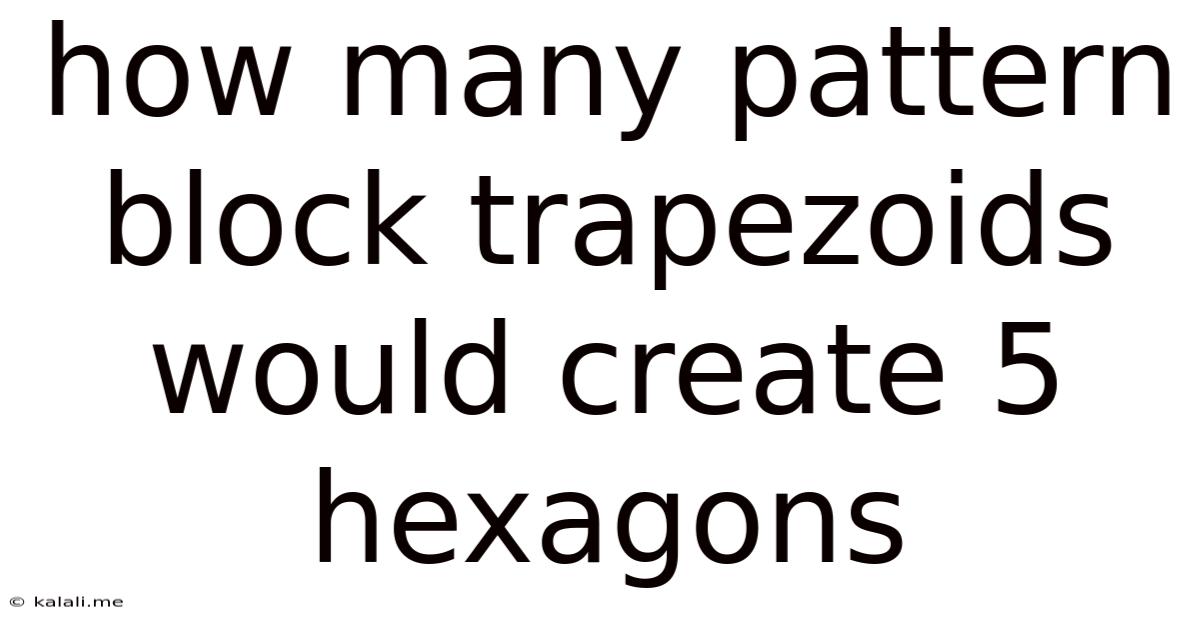How Many Pattern Block Trapezoids Would Create 5 Hexagons
Kalali
Jul 18, 2025 · 4 min read

Table of Contents
Decomposing Hexagons: How Many Trapezoids Make 5 Hexagons with Pattern Blocks?
Meta Description: Discover the fascinating geometric puzzle of constructing hexagons using pattern block trapezoids. This detailed guide explores the solution, delves into the mathematical concepts involved, and offers extension activities for further exploration. Learn how to visualize and calculate the number of trapezoids needed to create five hexagons using pattern blocks.
Pattern blocks are a fantastic tool for exploring geometric shapes and relationships. One common activity involves creating larger shapes from smaller constituent parts. Today, we’ll tackle a specific challenge: determining how many trapezoidal pattern blocks are needed to construct five hexagons. This seemingly simple problem offers a surprising depth of mathematical understanding, touching upon concepts like area, decomposition, and spatial reasoning.
This article will not only provide the answer but also detail the process of arriving at the solution, exploring alternative approaches, and suggesting extension activities to further your geometric exploration.
Understanding the Building Blocks: Pattern Block Trapezoids and Hexagons
Before diving into the problem, let's familiarize ourselves with the key players: the trapezoid and the hexagon.
-
Trapezoidal Pattern Block: This shape is a quadrilateral with one pair of parallel sides (bases). It's an isosceles trapezoid, meaning the non-parallel sides (legs) are of equal length. In the context of pattern blocks, its specific dimensions are crucial for the construction.
-
Hexagonal Pattern Block: This is a regular hexagon, meaning it has six equal sides and six equal interior angles (each measuring 120 degrees). Its symmetrical nature simplifies the process of building larger structures.
The challenge lies in understanding how the trapezoid's shape and dimensions fit within the hexagon's structure. We need to consider how many trapezoids are necessary to perfectly cover the area of a single hexagon, and then scale that up to five hexagons.
Solving the Puzzle: Constructing One Hexagon from Trapezoids
Let's start by building a single hexagon using trapezoids. Observe the pattern blocks carefully. You'll notice that three trapezoids can perfectly fit together to form one hexagon. This is because the angles of the trapezoids, when combined, create the 120-degree interior angles of the hexagon. Think of it like assembling a puzzle where the pieces (trapezoids) seamlessly interlock to form the complete picture (hexagon).
Visualizing the Construction: Imagine arranging three trapezoids such that their parallel sides (longer bases) are aligned to form a continuous straight line. The non-parallel sides will then naturally converge at the hexagon's vertices. This arrangement reveals the precise fit of three trapezoids into one hexagon.
Scaling Up: From One Hexagon to Five
Now that we know three trapezoids make one hexagon, we can easily extend this knowledge to determine the number of trapezoids needed for five hexagons. This is a simple multiplication problem:
3 trapezoids/hexagon * 5 hexagons = 15 trapezoids
Therefore, fifteen trapezoidal pattern blocks are required to construct five hexagons.
Alternative Approaches and Mathematical Concepts
While the direct calculation is straightforward, exploring alternative approaches can deepen our understanding of the underlying mathematical concepts.
-
Area Calculation: We could calculate the area of both the trapezoid and the hexagon, and then use these areas to determine the ratio and subsequently the number of trapezoids needed. However, this approach would require knowing the precise dimensions of the pattern blocks.
-
Tessellations: The arrangement of trapezoids forming a hexagon demonstrates a tessellation – a pattern of shapes that completely covers a plane without any overlaps or gaps. This property is fundamental to many geometric designs and structures.
-
Symmetry and Transformations: The symmetry inherent in both the trapezoid and the hexagon plays a significant role in their arrangement. The process of constructing the hexagon involves rotations and reflections of the trapezoid, which are key concepts in geometry.
Extension Activities and Further Exploration
The problem of constructing hexagons from trapezoids serves as a springboard for numerous extension activities that enhance mathematical exploration:
-
Different Shapes: Explore constructing other polygons (squares, triangles, octagons) using various combinations of pattern blocks. This will further your understanding of geometric relationships and area calculations.
-
Area and Perimeter: Calculate the area and perimeter of both the individual trapezoids and the assembled hexagon. Compare and contrast these measurements to understand their relationships.
-
3D Structures: Extend the exploration to three dimensions by using the pattern blocks to build cubes, prisms, and other 3D structures.
-
Problem Solving: Pose more complex problems, such as: "How many different ways can you construct a hexagon using a combination of trapezoids and other pattern blocks?"
Conclusion: Beyond the Numbers
This article has demonstrated that fifteen trapezoidal pattern blocks are necessary to construct five hexagons. However, the true value lies not just in the answer itself, but in the process of arriving at it. The problem fosters critical thinking, spatial reasoning, and the application of fundamental mathematical concepts. By exploring variations and extending the activity, students can cultivate a deeper appreciation for geometry and problem-solving skills. The seemingly simple act of assembling pattern blocks opens a door to a world of mathematical exploration, creativity, and discovery. So, grab your pattern blocks and start building! The possibilities are endless.
Latest Posts
Latest Posts
-
How Many Water Bottles Is 32 Ounces
Jul 18, 2025
-
The Region Of Georgia With The Most Rainfall
Jul 18, 2025
-
How To Say A Little Bit In Spanish
Jul 18, 2025
-
Speak Your Mind But Ride A Fast Horse
Jul 18, 2025
-
7000 Sq Ft Is How Many Acres
Jul 18, 2025
Related Post
Thank you for visiting our website which covers about How Many Pattern Block Trapezoids Would Create 5 Hexagons . We hope the information provided has been useful to you. Feel free to contact us if you have any questions or need further assistance. See you next time and don't miss to bookmark.